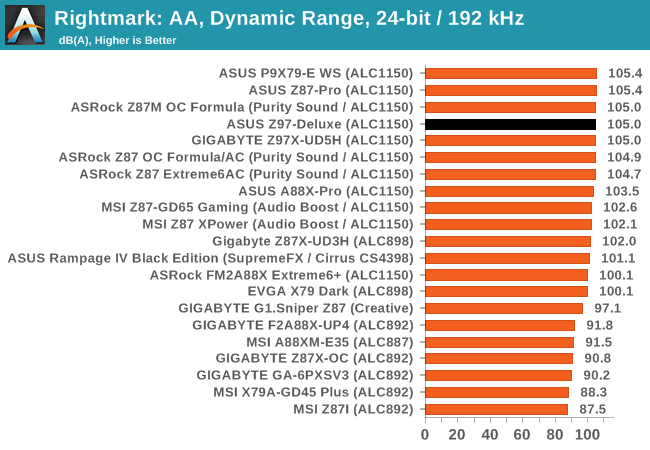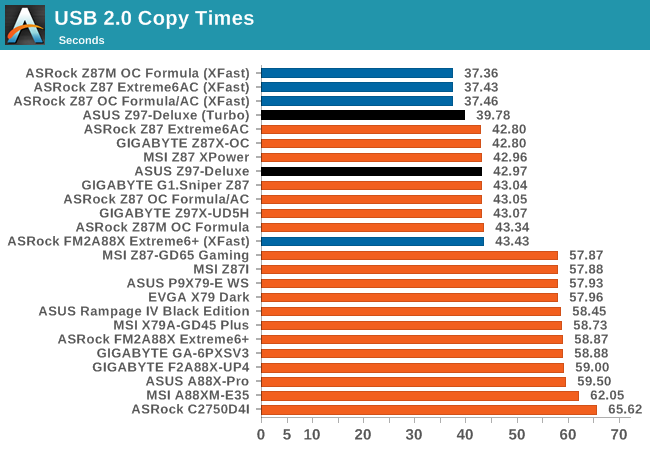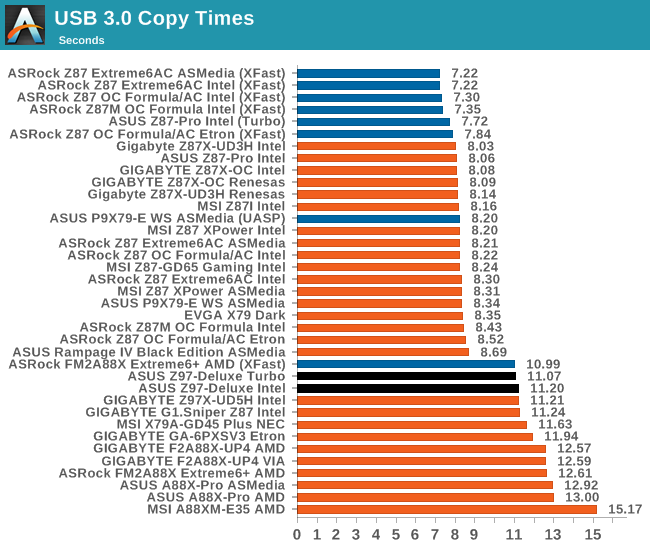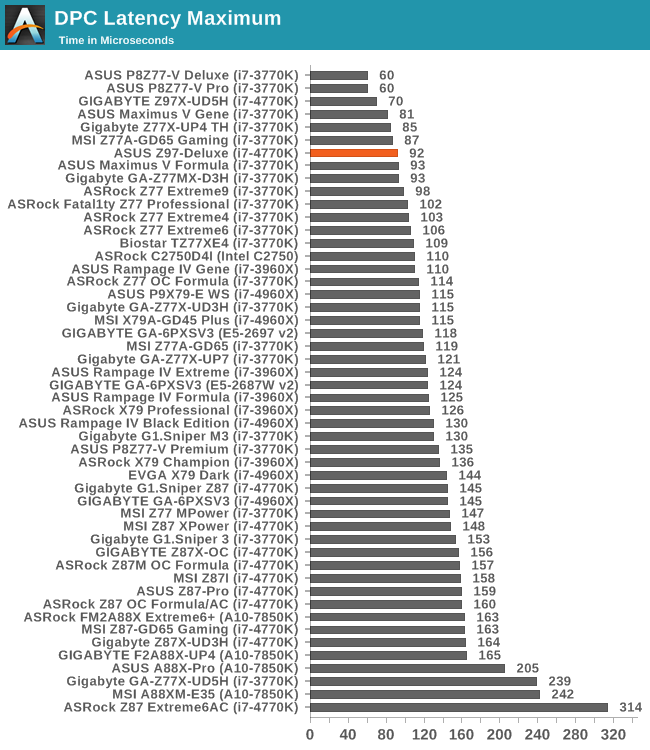ASUS Z97-DELUXE (NFC & WLC) Review: With Two Thunderbolt 2 Too
by Ian Cutress on May 16, 2014 11:00 AM EST- Posted in
- Motherboards
- Intel
- Asus
- NFC
- 802.11ac
- Thunderbolt 2
- Z97
- Wireless Charging
System Benchmarks
Rightmark Audio Analyzer 6.2.5
The premise behind Rightmark:AA is to test the input and output of the audio system to determine noise levels, range, harmonic distortion, stereo crosstalk and so forth. Rightmark:AA should indicate how well the sound system is built and isolated from electrical interference (either internally or externally). For this test we connect the Line Out to the Line In using a short six inch 3.5mm to 3.5mm high-quality jack, turn the OS speaker volume to 100%, and run the Rightmark default test suite at 192 kHz, 24-bit. The OS is tuned to 192 kHz/24-bit input and output, and the Line-In volume is adjusted until we have the best RMAA value in the mini-pretest. We look specifically at the Dynamic Range of the audio codec used on board, as well as the Total Harmonic Distortion + Noise.
Dynamic Range of the Z97-Deluxe


We had one small initial issue with our audio test on the Deluxe, causing distortion at 100% volume when the drivers off the disk were installed. The latest Realtek drivers from the ASUS website worked better, and gave some of the best audio results we have ever seen in our RMAA test.
USB Backup
For this benchmark, we run CrystalDiskMark to determine the ideal sequential read and write speeds for the USB port using our 240 GB OCZ Vertex3 SSD with a SATA 6 Gbps to USB 3.0 converter. Then we transfer a set size of files from the SSD to the USB drive using DiskBench, which monitors the time taken to transfer. The files transferred are a 1.52 GB set of 2867 files across 320 folders – 95% of these files are small typical website files, and the rest (90% of the size) are the videos used in the WinRAR test. In an update to pre-Z87 testing, we also run MaxCPU to load up one of the threads during the test which improves general performance up to 15% by causing all the internal pathways to run at full speed.


USB 2.0 performance with the Turbo mode activated did a good job with around a 10% time saving in the copy test. USB 3.0 gave a smaller increase, and judging by our current USB 3.0 tests on Z97, is a slight regression from Z87.
DPC Latency
Deferred Procedure Call latency is a way in which Windows handles interrupt servicing. In order to wait for a processor to acknowledge the request, the system will queue all interrupt requests by priority. Critical interrupts will be handled as soon as possible, whereas lesser priority requests, such as audio, will be further down the line. So if the audio device requires data, it will have to wait until the request is processed before the buffer is filled. If the device drivers of higher priority components in a system are poorly implemented, this can cause delays in request scheduling and process time, resulting in an empty audio buffer – this leads to characteristic audible pauses, pops and clicks. Having a bigger buffer and correctly implemented system drivers obviously helps in this regard. The DPC latency checker measures how much time is processing DPCs from driver invocation – the lower the value will result in better audio transfer at smaller buffer sizes. Results are measured in microseconds and taken as the peak latency while cycling through a series of short HD videos - less than 500 microseconds usually gets the green light, but the lower the better.

If there was one specific feature to fix from the 8-series motherboards, it was DPC Latency. Every Z87 motherboard we tested scored 150 microseconds or up (except for one at ~140). Like the UD5H, the Z97-Deluxe continues a good trend of below 100 microsecond results for Z97.











45 Comments
View All Comments
Tchamber - Monday, May 19, 2014 - link
Asus have come a long way since my last Asus board... for my old Pentium 4 CPU. This looks good, I want to upgrade when SATA Express becomes mainstream. I should think all us Star Wars fans would love this board/chipset!prophet001 - Monday, May 19, 2014 - link
Did you try booting the XP941 with this motherboard? Would love to see a Windows installation boot on it and get some benchmarks out.RamCity - Monday, May 19, 2014 - link
We just got some feedback from a customer this morning who has installed the XP941 in the ASUS Z97-Deluxe. These are the results with the latest bios dated 16th May (0901)1. With UEFI mode enabled, it's possible to begin a Windows 8 installation from DVD, but on the first reboot, the XP941 drive is not recognised, so the install couldn't proceed.
2. Customer was able to use the XP941 as storage once Windows 8 was installed to a different drive, but it doesn't show up in the list of bootable devices in the bios. He hasn't yet benchmarked the drive to see what sort of transfer speeds he can get out of it.
3. With the previous version bios, he couldn't even begin the windows installation, so it seems ASUS are working on this. Feedback we have from ASUS HQ in Europe is that they are working on getting the XP941 to boot in legacy mode.
4. The customer actually bought an ASRock Z97 Extreme6 as well and had no issues booting and installing Windows on the XP941 (installed in the M.2 socket), and confirmed it operated at full 1200/950MB/s transfer speeds.
My feeling is that it's only a matter of time before ASUS has a bios update which will allow the XP941 to have the OS installed and be bootable, but at this point it's not possible (at least from one customers point of view, and he seemed very technically astute)
Rod (vendor rep for ramcity.com.au)
prophet001 - Tuesday, May 20, 2014 - link
Thank you for the reply. Sounds exciting. Surely the floodgates are about to be opened on this technology.Timur Born - Tuesday, June 10, 2014 - link
How does audio sound once connected to speaker with 3-prong (earth line) speaker system? Like the ones that really would benefit from the audio specs written on paper, not the cheapish 2-prong desktop speaker systems.It's troubling how hard it is to find a modern mainboard that does not amplify all kinds of electronic noise (voltage) over its ground lines (anything made of metal metal), which affects both internal and external audio (PCIe, USB, FW). This is not really a ground-loop issue, but one of noisy ground lines on motherboards (while the PSU and interestingly SATA port ground remains rather clean/unamplified).